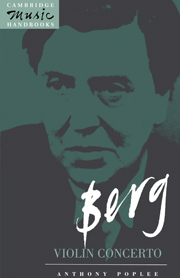6 - Reception and critical evaluation
Published online by Cambridge University Press: 05 June 2012
Summary
The early reception of the concerto was, inevitably, conditioned by the exaggerated ideological discord of its era. The Vienna premiere (see pp. 44–5) was a case in point: Klemperer's high-profile commitment – matching that of Kleiber in his Berlin premiere of the Lulu Suite two years previously – was directly opposed by the criticism which appeared in the Nazi-orientated popular press. But the Germanic nations were not alone in associating the music of the Schoenberg school with a subversive ideology. In a newspaper review of Webern's performance of the concerto in London, the prominent critic Ernest Newman wrote not of atonality, but of ‘atonalism’:
No one, of course, would venture to lay it down, a priori, that atonalism could not express, say, the plain man's feelings about such things as love or death: but we were at least entitled to ask for a practical demonstration that a modern atonal Romeo could sing something to his Juliet which the rest of us would wish to overhear, or a mourning nation follow atonally a hero to his tomb. This evidence was not forthcoming; yet, until it was, there was no hope of atonalism sweeping the world.
Newman's talk of ‘atonalism sweeping the world’ is symptomatic of the way he chose to redraw the musical ideologies of his day in the image of the larger political conflict of the 1930s, with its tendency towards polarisation and imperialism.
- Type
- Chapter
- Information
- Berg: Violin Concerto , pp. 91 - 102Publisher: Cambridge University PressPrint publication year: 1991



